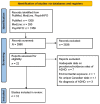A Review of Canadian Diagnosed ADHD Prevalence and Incidence Estimates Published in the Past Decade
- PMID: 36009114
- PMCID: PMC9406225
- DOI: 10.3390/brainsci12081051
A Review of Canadian Diagnosed ADHD Prevalence and Incidence Estimates Published in the Past Decade
Abstract
(1) Background: ADHD is recognized as one of the most common neurodevelopmental disorders. The worldwide prevalence of ADHD is estimated at 5.3%; however, estimates vary as a function of a number of factors, including diagnostic methods, age, sex and geographical location. A review of studies is needed to clarify the epidemiology of ADHD in Canada. (2) Methods: A search strategy was created in PubMed and adapted for MEDLINE and PsycINFO. Papers were included if they examined diagnosed ADHD prevalence and/or incidence rates in any region of Canada, age group and gender. A snowball technique was used to identify additional papers from reference lists, and experts in the field were consulted. (3) Results: Ten papers included in this review reported on prevalence, and one reported on incidence. One study provided an overall prevalence estimate across provinces for adults of 2.9%, and one study provided an overall estimate across five provinces for children and youth of 8.6%. Across age groups (1 to 24 years), incidence estimates ranged from 0.4% to 1.2%, depending on province. Estimates varied by age, gender, province, region and time. (4) Conclusions: The overall Canadian ADHD prevalence estimate is similar to worldwide estimates for adults. Most studies reported on prevalence rather than incidence. Differences in estimates across provinces may reflect the varying number of practitioners available to diagnose and prescribe medication for ADHD across provinces. To achieve a more comprehensive understanding of the epidemiology of ADHD in Canada, a study is needed that includes all provinces and territories, and that considers estimates in relation to age, gender, ethnicity, geographical region, socioeconomic status and access to mental healthcare coverage. Incidence rates need further examination to be determined.
Keywords: ADHD; Canada; epidemiology; incidence; prevalence.
Conflict of interest statement
The authors declare no conflict of interest.
Figures



Similar articles
-
Temporal Trends in the Prevalence and Incidence of Diagnosed ADHD in Children and Young Adults between 1999 and 2012 in Canada: A Data Linkage Study.Can J Psychiatry. 2017 Dec;62(12):818-826. doi: 10.1177/0706743717714468. Epub 2017 Jun 15. Can J Psychiatry. 2017. PMID: 28616934 Free PMC article.
-
[Estimating the Prevalence and Incidence Rate of Autism Spectrum Disorder (ASD): Interprovincial Comparisons].Sante Ment Que. 2018 Fall;43(2):65-81. Sante Ment Que. 2018. PMID: 32338686 French.
-
Temporal trends and geographical variability of the prevalence and incidence of attention deficit/hyperactivity disorder diagnoses among children in Catalonia, Spain.Sci Rep. 2020 Apr 14;10(1):6397. doi: 10.1038/s41598-020-63342-8. Sci Rep. 2020. PMID: 32286454 Free PMC article.
-
Global Economic Burden of Attention-Deficit/Hyperactivity Disorder: A Systematic Review.Pharmacoeconomics. 2021 Apr;39(4):399-420. doi: 10.1007/s40273-020-00998-0. Epub 2021 Feb 8. Pharmacoeconomics. 2021. PMID: 33554324
-
The effect of exposure to long working hours on stroke: A systematic review and meta-analysis from the WHO/ILO Joint Estimates of the Work-related Burden of Disease and Injury.Environ Int. 2020 Sep;142:105746. doi: 10.1016/j.envint.2020.105746. Epub 2020 Jun 3. Environ Int. 2020. PMID: 32505015
Cited by
-
Prevalence and risk factors of attention deficit hyperactive disorder among children aged 6-17 years in arbaminch City, Gamo zone, Southern Ethiopia: a community-based cross-sectional study.BMC Psychiatry. 2025 Feb 25;25(1):175. doi: 10.1186/s12888-025-06625-6. BMC Psychiatry. 2025. PMID: 40001069 Free PMC article.
-
ADHD medications use and risk of mortality and unintentional injuries: a population-based cohort study.Transl Psychiatry. 2024 Feb 28;14(1):128. doi: 10.1038/s41398-024-02825-y. Transl Psychiatry. 2024. PMID: 38418443 Free PMC article.
-
The Prevalence and Associated Factors of Attention Deficit Hyperactivity Disorder Among Primary School Children in Amman, Jordan.Cureus. 2023 Apr 19;15(4):e37856. doi: 10.7759/cureus.37856. eCollection 2023 Apr. Cureus. 2023. PMID: 37214023 Free PMC article.
-
A double-edged hashtag: Evaluation of #ADHD-related TikTok content and its associations with perceptions of ADHD.PLoS One. 2025 Mar 19;20(3):e0319335. doi: 10.1371/journal.pone.0319335. eCollection 2025. PLoS One. 2025. PMID: 40106389 Free PMC article.
-
Prevalence and Clinical Profile of Adults with ADHD Attending a Tertiary Care Hospital for Five Years.Int J Environ Res Public Health. 2024 Apr 29;21(5):566. doi: 10.3390/ijerph21050566. Int J Environ Res Public Health. 2024. PMID: 38791781 Free PMC article.
References
Publication types
LinkOut - more resources
Full Text Sources
Miscellaneous

